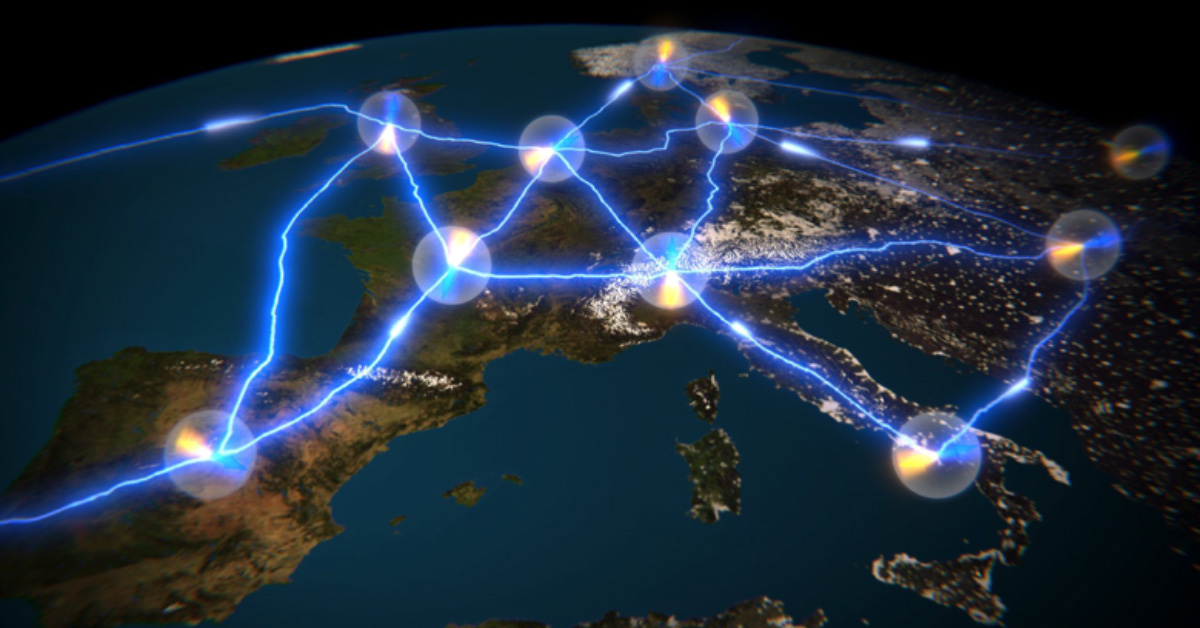With the rapid progress in applying the principles of quantum physics to the real world, this decade is shaping up to be the decade in which quantum computing really comes of age.
Yet with much less hype, physicists are also using quantum principles to shake up the field of communication.
Just as the internet, as we know it, followed the development of computers, expect the advent of functional quantum computers to usher in the era of the quantum internet.
Here we delve into some of its latest updates, where brilliant physicists have ingeniously overcome some of the greatest hurdles in laying the network of the future.
Long-distance relationships.
In their study published in Nature Photonics, Toshiba researchers announced a breakthrough in transmitting qubits of single photons over long distances, one of the toughest technological challenges in building the quantum internet.
The novel ‘dual band’ stabilisation technique allowed them to apply long-distance Quantum Key Distribution (QKD) – a secure communication method that uses properties found in quantum physics to exchange encryption keys only known between shared parties – over a record distance of more than 600 kilometres of optical fibre.
“This is a very exciting result,” says Mirko Pittaluga, lead author of the Nature Photonics paper. “With the new techniques we have developed, further extensions of the communication distance for QKD are still possible and our solutions can also be applied to other quantum communications protocols and applications”.
QKD will pave the way for a commercially viable global quantum-secure network. In this realm, users will be able to securely exchange confidential information (private calls, health records, bank statements) over an untrusted communication channel such as the internet. It’s also anticipated to be crucial in protecting operation-critical communications for governments and businesses.
Heating the quantum internet.
On the other hand, the Achilles heel of storing and transmitting stable qubits of light remains the need to store them at extremely low temperatures, where atoms almost stop moving.
But just like we’ve seen the world’s first room-temperature quantum computer, a team of researchers from the University of Copenhagen devised a way to store these qubits at room-temperature for a hundred times longer than before.
“In our memory chips, thousands of atoms are flying around emitting photons also known as qubits of light. When the atoms are exposed to heat, they start moving faster and collide with one another and with the walls of the chip. This leads them to emit photons that are very different from each other. But we need them to be exactly the same in order to use them for safe communication in the future,” explains Professor Eugene Polzik from the Niels Bohr Institute.
To solve this, the University of Copenhagen team developed a special coating for their chips to create identical and stable qubits of light at room-temperature for a much longer time. This step forward makes qubit storage possible sans complex and power-hungry cooling systems, allowing easier and cheaper implementation in a future quantum internet.
Their research could potentially complement Toshiba’s study, where a stable room-temperature qubit storage system could work hand-in-hand with a reliable qubit transmission strategy to supercharge research in developing the quantum network.
But wait – after all this talk, what exactly is a quantum internet and how can we benefit from it?
Quantum internet, explained.
A quantum internet describes a global network of quantum computers connected by long-distance communication links.
Quantum communication records information in qubits of light or photons, similar to how digital systems today use bits and bytes.
These qubits are central to the quantum internet due to quantum entanglement. Two entangled qubits, though geographically distant, would yield the same result during measurement.
This property would provide ultrafast solutions to complex optimisation problems in the cloud, a more accurate global timing system and extremely secure global communications between two parties that cannot be discovered by a third.
Liberated from the constraints of ‘classical’ networks, the quantum internet could introduce a whole new level of privacy, security and computational clout that is out of the question with today’s internet.
While an optimised and practical quantum network is still far-flung, recent quantum leaps in transmitting, storing and manipulating quantum information make it evident that a proof-of-concept is impending.
And we can’t wait for that day to come.




































